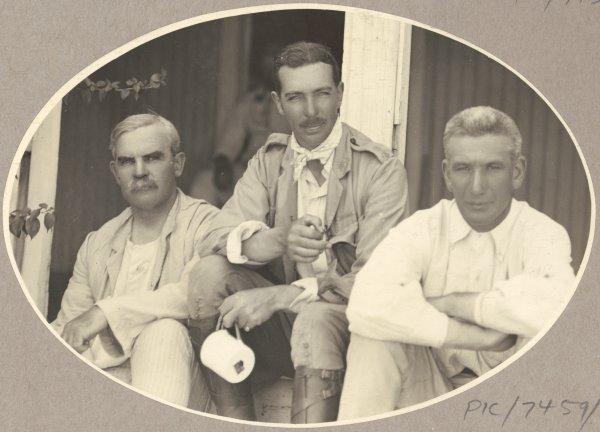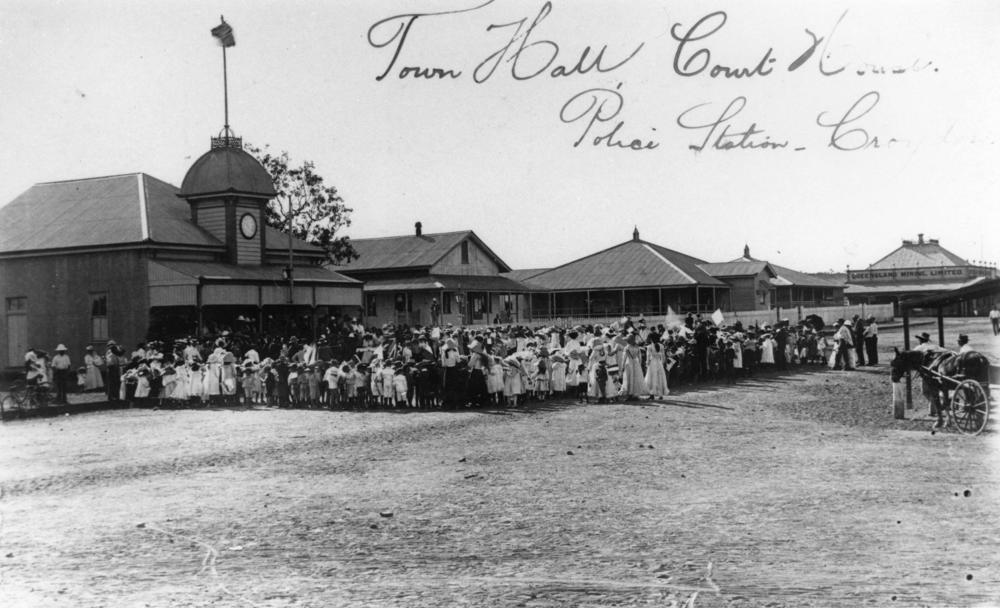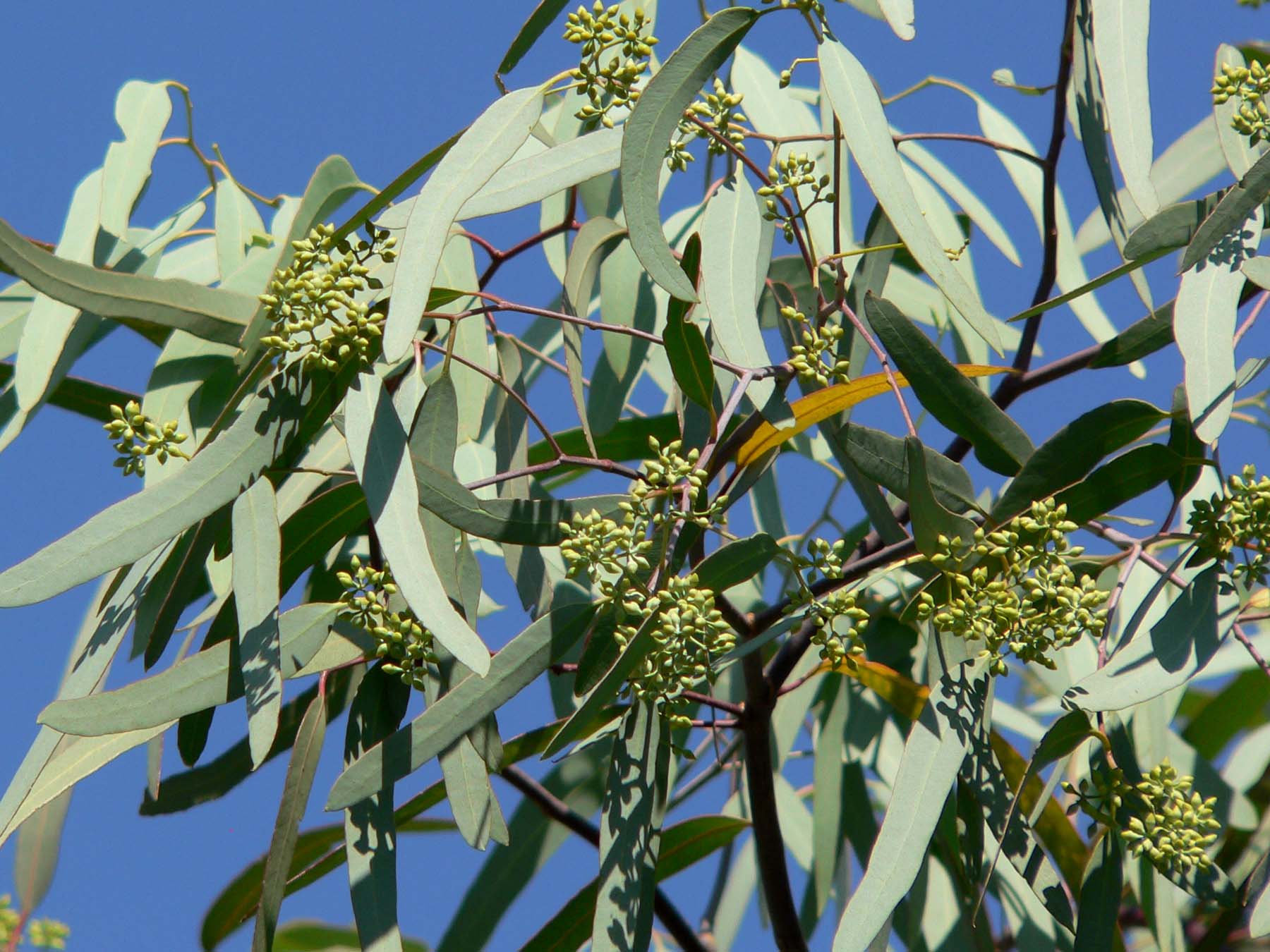|
Eucalyptus Distans
''Eucalyptus distans'', commonly known as the Katherine box, is a species of small tree that is endemic to northern parts of Australia. It has rough, fibrous grey bark, dull, narrow lance-shaped adult leaves, flower buds in groups of seven, creamy white flowers and cup-shaped to hemispherical or conical fruit. Description ''Eucalyptus distans'' is a tree that typically grows to a height of and forms a lignotuber. It has rough, fibrous, finely fissured grey bark with white patches. Young plants and coppice regrowth have narrow lance-shaped leaves long and wide. Adult leaves are the same dull, light green to grey-green colour on both sides, lance-shaped to curved, long and wide on a petiole long. The flower buds are arranged in leaf axils in groups of seven on a thin, branched peduncle long, the individual buds on a pedicel up to long. Mature buds are cylindrical to oval, long and about wide with a conical to rounded operculum. Flowering occurs between March and Apri ... [...More Info...] [...Related Items...] OR: [Wikipedia] [Google] [Baidu] |
Katherine, Northern Territory
Katherine is a town in the Northern Territory of Australia. It is situated on the Katherine River, after which it is named, southeast of Darwin. It is the fourth largest settlement in the Territory and is known as the place where "The outback meets the tropics". Katherine had an urban population of approximately 6,300 at the 2016 Census. Katherine is also the closest major town to RAAF Base Tindal, located southeast, and provides education, health, local government services and employment opportunities for the families of Defence personnel stationed there. In the , the base had a residential population of 857, with only around 20% of the workforce engaged in employment outside of defence, the majority commuting to work in Katherine. Katherine is also the central hub of the great "Savannah Way" which stretches from Cairns in north Queensland to Broome in the Kimberley region of Western Australia. Beginning as an outpost established with the Australian Overland Telegraph ... [...More Info...] [...Related Items...] OR: [Wikipedia] [Google] [Baidu] |
Synonym (taxonomy)
The Botanical and Zoological Codes of nomenclature treat the concept of synonymy differently. * In botanical nomenclature, a synonym is a scientific name that applies to a taxon that (now) goes by a different scientific name. For example, Linnaeus was the first to give a scientific name (under the currently used system of scientific nomenclature) to the Norway spruce, which he called ''Pinus abies''. This name is no longer in use, so it is now a synonym of the current scientific name, ''Picea abies''. * In zoology, moving a species from one genus to another results in a different binomen, but the name is considered an alternative combination rather than a synonym. The concept of synonymy in zoology is reserved for two names at the same rank that refers to a taxon at that rank - for example, the name ''Papilio prorsa'' Linnaeus, 1758 is a junior synonym of ''Papilio levana'' Linnaeus, 1758, being names for different seasonal forms of the species now referred to as ''Araschnia le ... [...More Info...] [...Related Items...] OR: [Wikipedia] [Google] [Baidu] |
Least Concern Species
A least-concern species is a species that has been categorized by the International Union for Conservation of Nature (IUCN) as evaluated as not being a focus of species conservation because the specific species is still plentiful in the wild. They do not qualify as threatened, near threatened, or (before 2001) conservation dependent. Species cannot be assigned the "Least Concern" category unless they have had their population status evaluated. That is, adequate information is needed to make a direct, or indirect, assessment of its risk of extinction based on its distribution or population status. Evaluation Since 2001 the category has had the abbreviation "LC", following the IUCN 2001 Categories & Criteria (version 3.1). Before 2001 "least concern" was a subcategory of the "Lower Risk" category and assigned the code "LR/lc" or lc. Around 20% of least concern taxa (3261 of 15636) in the IUCN database still use the code "LR/lc", which indicates they have not been re-evaluate ... [...More Info...] [...Related Items...] OR: [Wikipedia] [Google] [Baidu] |
International Union For The Conservation Of Nature
The International Union for Conservation of Nature (IUCN; officially International Union for Conservation of Nature and Natural Resources) is an international organization working in the field of nature conservation and sustainable use of natural resources. It is involved in data gathering and analysis, research, field projects, advocacy, and education. IUCN's mission is to "influence, encourage and assist societies throughout the world to conserve nature and to ensure that any use of natural resources is equitable and ecologically sustainable". Over the past decades, IUCN has widened its focus beyond conservation ecology and now incorporates issues related to sustainable development in its projects. IUCN does not itself aim to mobilize the public in support of nature conservation. It tries to influence the actions of governments, business and other stakeholders by providing information and advice and through building partnerships. The organization is best known to the wider ... [...More Info...] [...Related Items...] OR: [Wikipedia] [Google] [Baidu] |
Department Of Parks And Wildlife (Western Australia)
The Department of Parks and Wildlife (DPaW) was the department of the Government of Western Australia responsible for managing lands described in the ''Conservation and Land Management Act 1984'' and implementing the state's conservation and environment legislation and regulations. The minister responsible for the department was the Minister for the Environment. History The Department of Environment and Conservation (DEC) was separated on 30 June 2013, forming the Department of Parks and Wildlife (DPaW) and the Department of Environment Regulation (DER), both of which commenced operations on 1 July 2013. DPaW focused on managing multiple use state forests, national parks, marine parks and reserves. DER focused on environmental regulation, approvals and appeals processes, and pollution prevention. It was announced on 28 April 2017 that the Department of Parks and Wildlife would merge with the Botanic Gardens and Parks Authority, the Zoological Parks Authority and the Rott ... [...More Info...] [...Related Items...] OR: [Wikipedia] [Google] [Baidu] |
Declared Rare And Priority Flora List
The Declared Rare and Priority Flora List is the system by which Western Australia's conservation flora are given a priority. Developed by the Government of Western Australia's Department of Environment and Conservation, it was used extensively within the department, including the Western Australian Herbarium. The herbarium's journal, ''Nuytsia'', which has published over a quarter of the state's conservation taxa, requires a conservation status to be included in all publications of new Western Australian taxa that appear to be rare or endangered. The system defines six levels of priority taxa: ;X: Threatened (Declared Rare Flora) – Presumed Extinct Taxa: These are taxa that are thought to be extinct, either because they have not been collected for over 50 years despite thorough searching, or because all known wild populations have been destroyed. They have been declared as such in accordance with the Wildlife Conservation Act 1950, and are therefore afforded legislative protecti ... [...More Info...] [...Related Items...] OR: [Wikipedia] [Google] [Baidu] |
Croydon, Queensland
Croydon is a town and Suburbs and localities (Australia), locality within the Shire of Croydon in Queensland, Australia. It is a terminus for the Normanton to Croydon railway line, which operates the Gulflander tourist train. At the , Croydon had a population of 258 people. History The historic goldrush town of Croydon is located in the heart of the Gulf Savannah, west of Cairns. Mining in the area quickly drove out the Tagalag people, Tagalaka people indigenous to the area. Croydon was a large pastoral holding owned by Alexander Brown and Margaret Chalmers that covered an area of approximately , when first settled in the 1880s. The town's name is derived from a pastoral run name, that was used by their sons, Alexander Brown and William Chalmers Brown, pastoralists; William Chalmers Brown was born in Croydon, England in 1841 and is buried at Toowong Cemetery, Toowong cemetery in Brisbane. Gold was discovered in 1885 and by 1887, the town's population had reached 7,000. Croydon P ... [...More Info...] [...Related Items...] OR: [Wikipedia] [Google] [Baidu] |
Fitzroy Crossing, Western Australia
Fitzroy Crossing is a small town in the Kimberley region of Western Australia, east of Broome and west of Halls Creek. It is approximately from the state capital of Perth. It is above sea level and is situated on a low rise surrounded by the vast floodplains of the Fitzroy River and its tributary Margaret River. At the 2016 census, the population of the Fitzroy Crossing town-site was 1,297; with a further 2,000 or so people living in up to 50 Aboriginal communities scattered throughout the Fitzroy Valley. About 80% of the Fitzroy Valley population were Indigenous Australians with a split of closer to 60/40 (indigenous/non-indigenous) in the townsite. Tourism, cattle stations and mining are the main industries in the area. History Fitzroy Crossing and the lands and valleys around it were the home for a number of Aboriginal language groups. When Fitzroy Crossing was established the main group was the Bunuba people, their land stretching from the present day Brooking Spring ... [...More Info...] [...Related Items...] OR: [Wikipedia] [Google] [Baidu] |
Disjunct Distribution
In biology, a taxon with a disjunct distribution is one that has two or more groups that are related but considerably separated from each other geographically. The causes are varied and might demonstrate either the expansion or contraction of a species' range. Range fragmentation Also called range fragmentation, disjunct distributions may be caused by changes in the environment, such as mountain building and continental drift or rising sea levels; it may also be due to an organism expanding its range into new areas, by such means as rafting, or other animals transporting an organism to a new location (plant seeds consumed by birds and animals can be moved to new locations during bird or animal migrations, and those seeds can be deposited in new locations in fecal matter). Other conditions that can produce disjunct distributions include: flooding, or changes in wind, stream, and current flows, plus others such as anthropogenic introduction of alien introduced species either acciden ... [...More Info...] [...Related Items...] OR: [Wikipedia] [Google] [Baidu] |
Gove, Northern Territory
The Gove Peninsula is at the northeastern corner of Arnhem Land in the Northern Territory of Australia. The peninsula became strategically important during World War II when a Royal Australian Air Force base was constructed at what is now Gove Airport. The peninsula was involved in a famous court case known as the Gove land rights case, when local Yolngu people tried to claim native title over their traditional lands in 1971, after the Australian Government had granted a mineral lease to a bauxite mining company without consulting the local peoples. Today the land is owned by the Yolngu people. Location The Gove Peninsula is on the west coast of the Gulf of Carpentaria within Arnhem Land, a vast tract of Aboriginal-owned land on the Northern Territory coastline. The township of Nhulunbuy is the main commercial and service centre of the Peninsula and is 600 kilometres east of Darwin. History Modern As Europeans started land exploration throughout the Northern Territory an ... [...More Info...] [...Related Items...] OR: [Wikipedia] [Google] [Baidu] |
Northern Territory
The Northern Territory (commonly abbreviated as NT; formally the Northern Territory of Australia) is an states and territories of Australia, Australian territory in the central and central northern regions of Australia. The Northern Territory shares its borders with Western Australia to the west (129th meridian east), South Australia to the south (26th parallel south), and Queensland to the east (138th meridian east). To the north, the territory looks out to the Timor Sea, the Arafura Sea and the Gulf of Carpentaria, including Western New Guinea and other islands of the Indonesian archipelago. The NT covers , making it the third-largest Australian federal division, and List of country subdivisions by area, the 11th-largest country subdivision in the world. It is sparsely populated, with a population of only 249,000 – fewer than half as many people as in Tasmania. The largest population center is the capital city of Darwin, Northern Territory, Darwin. The archaeological hist ... [...More Info...] [...Related Items...] OR: [Wikipedia] [Google] [Baidu] |
Eucalyptus Microtheca
''Eucalyptus microtheca'', commonly known as the coolibah, is a species of tree that is endemic to northern Australia. It has rough, flaky or fibrous bark on the trunk and branches, lance-shaped adult leaves, flower buds in groups of seven, white flowers and spherical to conical fruit. It is widely distributed from the Kimberley region of Western Australia to Cape York in Queensland. Description ''Eucalyptus microtheca'' is a tree, sometimes a mallee, that typically grows to a height of and forms a lignotuber. It has a whitish grey to dark grey, box-type bark that is often deeply fissured, coarsely flaky or tessellated as it ages. Young plants and coppice regrowth have narrow lance-shaped leaves that are long, wide and petiolate. Adult plants have leaves that are the same shade of dull green to bluish on both sides, lance-shaped to curved, long and wide, tapering to a petiole long. The flower buds are arranged on a thin, branched peduncle in groups of seven, the pedunc ... [...More Info...] [...Related Items...] OR: [Wikipedia] [Google] [Baidu] |









